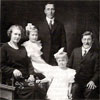Carl Langer
Carl Langer moved to Canada with his brother Paul in 1902. They each purchased homesteads north of Eckville, Alberta. Carl married Anna Teener in 1908. She too emigrated from Estonia in the 1900s. To help develop his financial stability, Carl worked for the Canadian Pacific Railway. Clearing the land for farming was an arduous and grueling process requiring remarkable physical endurance.
 Around 1908, the Langer brothers purchased a steam engine and threshing machine by taking out mortgages on their respective homesteads and any other property deemed valuable. Because it was the only steam-powered threshing machine in the vicinity, the Langer's offered their threshing services to other nearby farmers. Threshing, which separates grain kernels from straw, was extremely important. The straw provided bedding for animals and insulation for houses. The grain provided food. In the winter, if the snow was too deep, the men would anchor six horses to the steam engine to provide mobility through the uncooperative terrain. Threshing costs were typically set at $1 per day. The Langer brothers however, received most payments in the form of grain or manual labour. Paul was recognized as an official steam engineer when he obtained a government-issued boiler engineer's certificate. Despite the usefulness and productivity of the steam engine and thresher, Carl and Paul both recognized how important a reliable and healthy horse was for travel and work.
Around 1908, the Langer brothers purchased a steam engine and threshing machine by taking out mortgages on their respective homesteads and any other property deemed valuable. Because it was the only steam-powered threshing machine in the vicinity, the Langer's offered their threshing services to other nearby farmers. Threshing, which separates grain kernels from straw, was extremely important. The straw provided bedding for animals and insulation for houses. The grain provided food. In the winter, if the snow was too deep, the men would anchor six horses to the steam engine to provide mobility through the uncooperative terrain. Threshing costs were typically set at $1 per day. The Langer brothers however, received most payments in the form of grain or manual labour. Paul was recognized as an official steam engineer when he obtained a government-issued boiler engineer's certificate. Despite the usefulness and productivity of the steam engine and thresher, Carl and Paul both recognized how important a reliable and healthy horse was for travel and work.
Carl, with the help of Fritz Kinna and Charlie Raabis, built a brush cutter powered by six horses. This apparatus was used to clear land and construct roadways. Every piece of equipment was hand-built by the three Estonian settlers. Continuing his interest in technology, Carl purchased an Everett Touring car complete with a folding roof, removable curtains, and running boards. Carl was an integral part of Medicine Valley's Estonian community and donated some of his land to the construction of the Estonian school. Moreover, he served as the director of the Eckville and Gilby Co-operative Company. Carl and his wife Anna had a family of six sons and one daughter.








